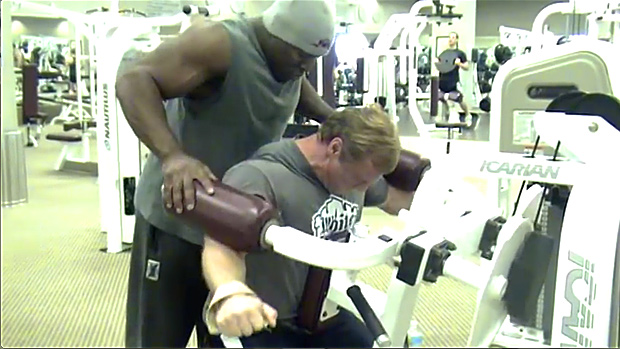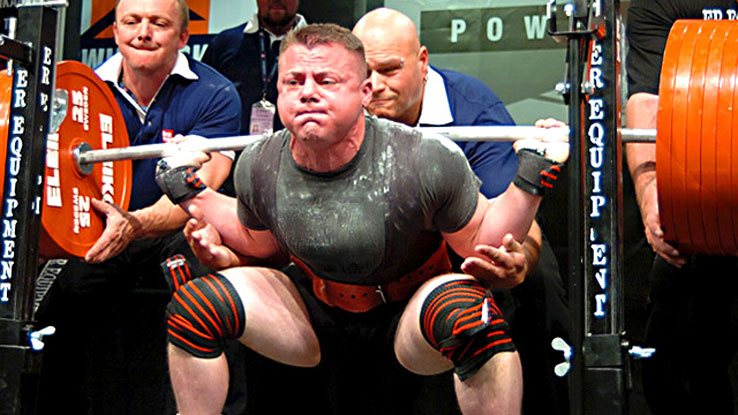Much like a voluptuous vixen who loves to cook and clean, endurance-based conditioning programs that won't wreak havoc on strength and hypertrophy are hard to come by.
If you neglect maximal strength training parameters in your workout plan, you'll never reach your full muscular or athletic potential. Sticking primarily to many of the popular endurance programs out there will benefit you in one way – you'll become the guy who's good at running away from the strong guys.
There are no absolutes when it comes to training parameters, but generally speaking, I don't like high-repetition, short-rest period training programs. They're not ideal for fat loss; they're rarely the best way to improve conditioning levels; and most of all, they'll turn you into a limp-wristed Nancy boy who buckles under heavy loads.
Let's take a look at why those who primarily follow endurance programs are built like a seven-year-old girl.
The Problem with Typical Endurance Programs
If you seek optimum results, you shouldn't follow traditional periodization guidelines that consist of focusing on a single strength and conditioning quality (not even two) throughout an entire mesocycle. If you do, whatever strength quality you're neglecting will quickly diminish.
So if you've been misguided enough to think that high-repetition, short-rest period training programs are your ticket to a leaner, meaner physique–think again. Those endurance strength training programs focus on developing the puny, type I muscle fibers.
Also, endurance programs train the motor units of the type I fibers to become more efficient. For those of you who don't know, muscle fibers aren't innervated by a general motor neuron type. Each fiber type (type I, type IIA and type IIB) has different motor neurons that either fire weak and slow (type I), or strong and fast (type IIA, IIB).
You're probably thinking, "How do I know which fiber types I'm training?" Well, it depends on training load, reps, sets, tempo and rest period. Simple, eh? But I don't want to turn this article into a ten-pound manuscript so I'll keep it very simple. Here are the general guidelines for knowing which fiber type is primarily being trained (this information is only accurate if the load causes failure in the specified time frame):
Muscle Fiber TypeDuration of Set
Type IIB<10 seconds
Type IIA10-120 seconds
Type I120 seconds+
Note: My colleagues and I could argue about this table all day. It's based on the function of the energy systems for muscle actions and the time before fatigue of certain motor neurons. It's not perfect, but it serves its purpose for this article.
The problem with utilizing high repetition, short-rest-period training extends far beyond a decrease in maximal strength. Simoneau et al performed a study that clearly showed the detrimental effects that continuous endurance training can have on your maximum hypertrophy efforts. They had 24 subjects undergo an endurance program over a period of 15 weeks. At the end of the study, muscle biopsies revealed a significant gain in the percentage of type I endurance muscle fiber qualities with a subsequent decrease in type IIB fiber qualities (1).
This is bad news for those who are interested in maximal strength and size as the fewer the type IIB fiber qualities, the less potential for greater strength and size. In other words, if you stray from training the type IIB fibers/motor units because you seek a more "conditioned" physique, you'll have a hell of a tough time gaining strength and size when you return to maximal strength training.
As if that isn't enough bad news for you, I've got more. Studies with endurance-training protocols demonstrated a decrease in size of aerobically-trained myofibrils. In other words, continuous aerobic training will decrease the size of the trained muscle fibers! The body forces the fibers to become smaller and thinner to achieve better perfusion (nutrient transfer) within the fibers (2). That's good for endurance, but very bad for hypertrophy.
Lemons into Lemonade
As with anything in life, there's something valuable to be learned from all scientific discoveries. Ingjer looked at other features of muscle that were endurance-trained. He concluded that endurance training increased the number of capillaries around all muscle fiber types (3). This was very important data since an increase in capillary density will increase nutrient transfer and recovery rates.
I broke new hypertrophy-inducing ground when I introduced the training world to my 100 Reps to Bigger Muscles protocol that utilizes high-repetition endurance training on non-strength training days to facilitate an increase in capillary density without a significant conversion of type IIB to type I qualities. My personal observations with clients led me to suspect that an adequately designed high-rep, supplemental workout could have beneficial effects. But it wasn't until hundreds, if not thousands, of Testosterone readers absolutely confirmed my hypothesis with unequivocal, real-world data by trying out the program.
For some people, though, too much just isn't enough. I've received numerous inquiries about following my 100 Reps to Bigger Muscles parameters for all muscle groups, all the time. Bad idea. Some type of maximal or low-repetition hypertrophy parameters should always be included in your training cycle. If not, you'll quickly turn into a Woody Allen look-a-like whose only shot at impressing chicks is by curling an 8 lb. dumbbell 100 times.
Motor Units for Greater Strength and Size
For maximum hypertrophy, the Type IIB motor units must be recruited. I've stated it so many times it hurts – Type IIB fibers have the greatest potential for strength and size enhancement. If you neglect them, you're hindering your progress.
This is why training with large loads is mandatory for strength and hypertrophy development. Utilizing the 10 x 3-5 or 5 x 5 parameters are excellent methods for strength and size development. Most of the high-repetition conditioning programs with short rest periods will make you weak and small (German Volume Training included).
I designed the Outlaw Strength and Conditioning (OSC) program to utilize low repetitions and short rest periods in order to maintain maximal strength levels while subsequently turning you into an aerobically efficient, ass-stomping machine. What I wanted to show the training world, and what made the OSC program so unique, was that it proved an endurance/conditioning program could be devised using: low repetitions, larger than normal loads, and very short rest periods. The program is awesome, albeit, in retrospect, poorly named.
But type IIB fibers aren't the only fibers with potential for growth. Working type IIA fibers will also aid your hypertrophy-enhancing efforts. That's why it's not a good idea to focus on one set of parameters throughout a training cycle. Even if you chose an effective set/rep scheme for strength/hypertrophy (10 x 3), you'd be solely focusing on the type IIB fibers, and neglecting the type IIA (obviously, the same is true for training type IIA and neglecting type IIB).
As such, I designed the Anti-Bodybuilding Hypertrophy program to adequately tax both sets of fiber types for maximum growth. My point is that you should seek and design programs that constantly vary loading and repetition patterns to tax all type II fiber types.
Take Home Points
1. Programs primarily designed around high repetition, short-rest period parameters will make you small and weak, whether you like it or not.
2. Programs designed with set, unchanging parameters will cause you to neglect other important strength qualities, such as muscle fibers and motor neurons.
3. Always include at least one workout/week with some type of low-repetition (<5 reps) parameters, using a load that's at least a 6 RM (repetition maximum).
4. Alternate high-repetition training with strength/hypertrophy training on a weekly basis. Pure endurance phases will turn you into Paul Ruebens, aka PeeWee Herman.
5. If you seek increased endurance/conditioning levels without losing strength and size, utilize low-repetition sets with very short rest periods (5-60s).
Here are the parameters I recommend based on everything I've pointed out in this article. You can use them to design your own blood and guts conditioning program for endurance:
Waterbury Endurance-Training Guidelines
1. Use a load that's no less than a 6 RM (repetition maximum).
2. Use short-duration rest periods (5-60s) between sets to challenge the cardiovascular and lactic acid systems.
3. Use multiple sets (5-12) per body part and keep adding more sets over time to increase the volume of the workout.
4. Lift the load as quickly as possible to activate the explosive motor units.
5. Also, use high repetition, light training with adequate rest periods on the order of at least 2 minutes rest between sets. Or perform these on your non-strength training days for increasing capillary density and greater sarcoplasmic hypertrophy.
So now you know how to train for greater endurance and increased conditioning levels if you want to be a lean, explosive, ass-kickin' Taj Mahal of muscle. Don't follow those old-school endurance guidelines or else you too will end up lookin' like a Nancy boy!
References
1. Simoneau, J.A. , G. Lortie, M.R. Bonlay, C.M. Marcotte, M.C. Thibault, and C. Bouchard. Human skeletal muscle fibre type alteration with high-intensity intermittent training. Eur. J. Appl. Physiol. 54:250-253, 1985.
2. Goldspink G. The proliferation of myofibrils during muscle fibre growth. J. Cell Sci. 6:593-603, 1970.
3. Ingjer F. Effects of endurance training on muscle fibre ATP-ase activity, capillary supply and mitochondrial content in man. J. Physiol. (Lond.) 294:419-432, 1979.




